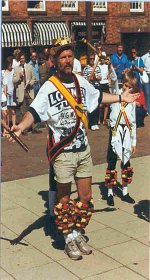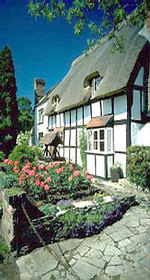The last unspoilt County in England
Herefordshire - the county of unspoilt countryside, market towns of distinctive character and a wealth of varied landscapes - from the Historic City of Hereford to fascinating villages. The richness of the natural environment forms a backdrop to a more leisurely pace of life and where innovation and inspiration blend with the County's historic rural past.
Gardens open to visitors offer a unique glimpse of the elegance of past times from formal to cottage-style all still nurtured by enthusiasts.
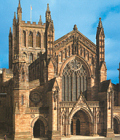 Hereford is the Cathedral City with the relaxed atmosphere of a country market town. Its origin dates back to Saxon times and today visitors delight in the harmony of a rich heritage and modern facilities. A historic centre of international importance, the magnificent Hereford Cathedral hosts Europe's oldest Music Festival every three years- The Three Choirs Festival Hereford is the Cathedral City with the relaxed atmosphere of a country market town. Its origin dates back to Saxon times and today visitors delight in the harmony of a rich heritage and modern facilities. A historic centre of international importance, the magnificent Hereford Cathedral hosts Europe's oldest Music Festival every three years- The Three Choirs Festival
 The Black and White Trail was developed as a means of encouraging visitors to take a closer look at the beautiful countryside and villages between Leominster and Kington in the north-west of Herefordshire. The trail, as the name suggests, is characterised by the large number of timbered and half-timbered houses in the area some dating from mediaeval times, others from more recent periods. Eardisland is about 6 miles due west of Leominster and the bridge in the background carries the B4529 road to Leominster over the river. The Black and White Trail was developed as a means of encouraging visitors to take a closer look at the beautiful countryside and villages between Leominster and Kington in the north-west of Herefordshire. The trail, as the name suggests, is characterised by the large number of timbered and half-timbered houses in the area some dating from mediaeval times, others from more recent periods. Eardisland is about 6 miles due west of Leominster and the bridge in the background carries the B4529 road to Leominster over the river.
 At Bromyard, you can see rural England at its best. Traditional countryside events, such as Bromyard Steam Gala in July and Bromyard Folk Festival in September are held annually. Nearby is Brockhampton Estate where you can enjoy walks through miles of park and woodland, home to a rich variety of wildlife and the chance to visit a medieval moated manor house. At Bromyard, you can see rural England at its best. Traditional countryside events, such as Bromyard Steam Gala in July and Bromyard Folk Festival in September are held annually. Nearby is Brockhampton Estate where you can enjoy walks through miles of park and woodland, home to a rich variety of wildlife and the chance to visit a medieval moated manor house.
Many Herefordshire Inns, Pubs and Restaurants serve delicious selections of locally grown produce with the county boasting many award-winning establishments.
Kington, a small historic market town on 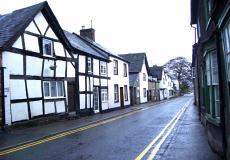 the English/Welsh border mentioned as 'Chingtune' in the Doomsday Book, is a natural focus for walkers. To the north, Offa's Dyke Path and the Mortimer Trail bounder the beautiful scenery of Mortimer Country. Offa’s Dyke Path continues to the south, with the Black Mountains and the River Dore on either side of the splendid walking country of the Golden Valley, connecting with the Wye Valley Walk in the book town of Hay-on-Wye. Before the Industrial Revolution, Kington owed its importance to its agricultural base and its strategic line of communication between England and Wales. the English/Welsh border mentioned as 'Chingtune' in the Doomsday Book, is a natural focus for walkers. To the north, Offa's Dyke Path and the Mortimer Trail bounder the beautiful scenery of Mortimer Country. Offa’s Dyke Path continues to the south, with the Black Mountains and the River Dore on either side of the splendid walking country of the Golden Valley, connecting with the Wye Valley Walk in the book town of Hay-on-Wye. Before the Industrial Revolution, Kington owed its importance to its agricultural base and its strategic line of communication between England and Wales.
 Ledbury in the east of the county, is one of England's text book market towns, full of prime examples of timber-framed buildings. The 17th century black & white Market House, which had originally served as a grain store dominates the town centre,and is supported on pillars of chestnut.it was completed in 1653 by John Abel, the Kings carpenter, another fine example of black & white architecture is The Feather’s Hotel on the High Street. Ledbury in the east of the county, is one of England's text book market towns, full of prime examples of timber-framed buildings. The 17th century black & white Market House, which had originally served as a grain store dominates the town centre,and is supported on pillars of chestnut.it was completed in 1653 by John Abel, the Kings carpenter, another fine example of black & white architecture is The Feather’s Hotel on the High Street.
Leominster lies to the north in the heart of the Marches, the  beautiful borderlands of England and Wales.The town dates from the 7th century and its history can be seen throughout the town, The 11th century Priory Church which is renowned for having three naves, a 45 foot perpendicular window and a well preserved 'ducking stool', was in use up to early 19th century, to 'still the tongues of nagging women'! and towers above this delightful Market Town. The town is rich in historic buildings,The narrow streets and timber framing retain much of the mediaeval and Tudor characteristics. Market day is Friday when Corn Square is thronged with people around the stalls. Antique shops are the town’s specialty ranging from cheap and cheerful to fine art auctions.and you will find many Antique shops improving your chance of finding real bargains. beautiful borderlands of England and Wales.The town dates from the 7th century and its history can be seen throughout the town, The 11th century Priory Church which is renowned for having three naves, a 45 foot perpendicular window and a well preserved 'ducking stool', was in use up to early 19th century, to 'still the tongues of nagging women'! and towers above this delightful Market Town. The town is rich in historic buildings,The narrow streets and timber framing retain much of the mediaeval and Tudor characteristics. Market day is Friday when Corn Square is thronged with people around the stalls. Antique shops are the town’s specialty ranging from cheap and cheerful to fine art auctions.and you will find many Antique shops improving your chance of finding real bargains.
Just a five miles from Ledbury on the A449 Ross on Wye road is the village of Much Marcle,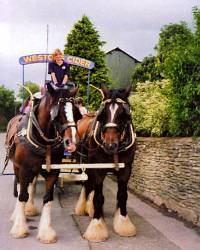 this village has much to offer the visitor young and old, Westons Cider is made here and it is possible to tour the cider making plant and to make purchases of cider, taste free samples in the shop and buy other mementoes. Besides this Weston's have a Rare Breed enclosure for cattle. There is the opportunity to ride on the Brewers Dray which transports passengers on a ride through the village. this village has much to offer the visitor young and old, Westons Cider is made here and it is possible to tour the cider making plant and to make purchases of cider, taste free samples in the shop and buy other mementoes. Besides this Weston's have a Rare Breed enclosure for cattle. There is the opportunity to ride on the Brewers Dray which transports passengers on a ride through the village.
Coddington Vineyard is also near to Ledbury, and can be reached by the B4214 from Ledbury or the A449 being signposted from those roads, here in a beautiful setting is a vineyard that produces some 4000 bottles of wine , three varieties of grapes are grown. Once an apple orchard, the owners Dennis and Ann Savage replaced the trees in 1985 and had their first crop of grapes in 1989, on site in an outbuilding close to the 17th century farmhouse is a shop where wines and pottery can be purchased.
Coddington vineyard has been described as one of the most beautiful vineyards in England. It lies below the Malvern Hills in an area of outstanding beauty. It is a small family business with a two acre vineyard and modern winery. Bacchus, one of the most widely planted grape varieties in England, excels here. This is an early ripening cross of Sylvaner, Riesling and Muller Thurgau. It is pleasantly scented, dry with good acidity with a hint of Gewurztraminer and Sauvignon Blanc.
Herefordshire is an enticing proposition for walkers who love peace and tranquility. As perhaps the most rural county in England, 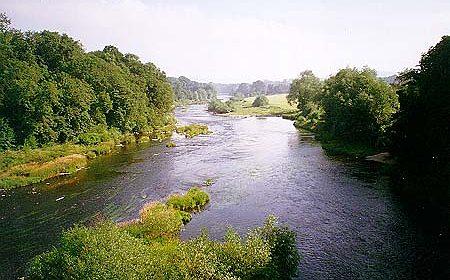 Herefordshire offers a wealth of unspoilt countryside where you can find solitude in which to reflect on the beauty around you. Herefordshire displays a rich diversity of character and landscape. To the east its gentle rolling countryside, green fields and rounded hills, interspersed with charming 'black and white' villages, exhibit many of those features which we think of as typically and traditionally English. To the west, with its rugged hills and dramatic views, the county becomes more Welsh, not only in appearance but also in its climate and its people. Herefordshire offers a wealth of unspoilt countryside where you can find solitude in which to reflect on the beauty around you. Herefordshire displays a rich diversity of character and landscape. To the east its gentle rolling countryside, green fields and rounded hills, interspersed with charming 'black and white' villages, exhibit many of those features which we think of as typically and traditionally English. To the west, with its rugged hills and dramatic views, the county becomes more Welsh, not only in appearance but also in its climate and its people. |

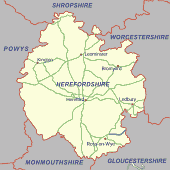


 The
The  At
At  the English/Welsh border mentioned as 'Chingtune' in the Doomsday Book, is a natural focus for walkers. To the north, Offa's Dyke Path and the Mortimer Trail bounder the beautiful scenery of Mortimer Country. Offa’s Dyke Path continues to the south, with the Black Mountains and the River Dore on either side of the splendid walking country of the Golden Valley, connecting with the
the English/Welsh border mentioned as 'Chingtune' in the Doomsday Book, is a natural focus for walkers. To the north, Offa's Dyke Path and the Mortimer Trail bounder the beautiful scenery of Mortimer Country. Offa’s Dyke Path continues to the south, with the Black Mountains and the River Dore on either side of the splendid walking country of the Golden Valley, connecting with the 
 beautiful borderlands of England and Wales.The town dates from the 7th century and its history can be seen throughout the town, The 11th century Priory Church which is renowned for having three naves, a 45 foot perpendicular window and a well preserved 'ducking stool', was in use up to early 19th century, to 'still the tongues of nagging women'! and towers above this delightful Market Town. The town is rich in historic buildings,The narrow streets and timber framing retain much of the mediaeval and Tudor characteristics. Market day is Friday when Corn Square is thronged with people around the stalls. Antique shops are the town’s specialty ranging from cheap and cheerful to fine art auctions.and you will find many Antique shops improving your chance of finding real bargains.
beautiful borderlands of England and Wales.The town dates from the 7th century and its history can be seen throughout the town, The 11th century Priory Church which is renowned for having three naves, a 45 foot perpendicular window and a well preserved 'ducking stool', was in use up to early 19th century, to 'still the tongues of nagging women'! and towers above this delightful Market Town. The town is rich in historic buildings,The narrow streets and timber framing retain much of the mediaeval and Tudor characteristics. Market day is Friday when Corn Square is thronged with people around the stalls. Antique shops are the town’s specialty ranging from cheap and cheerful to fine art auctions.and you will find many Antique shops improving your chance of finding real bargains. this village has much to offer the visitor young and old, Westons Cider is made here and it is possible to tour the cider making plant and to make purchases of cider, taste free samples in the shop and buy other mementoes. Besides this Weston's have a Rare Breed enclosure for cattle. There is the opportunity to ride on the Brewers Dray which transports passengers on a ride through the village.
this village has much to offer the visitor young and old, Westons Cider is made here and it is possible to tour the cider making plant and to make purchases of cider, taste free samples in the shop and buy other mementoes. Besides this Weston's have a Rare Breed enclosure for cattle. There is the opportunity to ride on the Brewers Dray which transports passengers on a ride through the village.  Herefordshire offers a wealth of unspoilt countryside where you can find solitude in which to reflect on the beauty around you. Herefordshire displays a rich diversity of character and landscape. To the east its gentle rolling countryside, green fields and rounded hills, interspersed with charming '
Herefordshire offers a wealth of unspoilt countryside where you can find solitude in which to reflect on the beauty around you. Herefordshire displays a rich diversity of character and landscape. To the east its gentle rolling countryside, green fields and rounded hills, interspersed with charming '